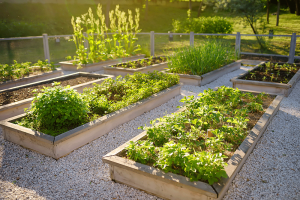Prepare to Garden after a Disaster Situation
February 2, 2023 by admin
Filed under Survival Tools
Gardening can be a powerful tool for recovery and healing after a natural disaster. In the aftermath of a disaster, communities can come together to create community gardens as a way to bring people together and provide access to fresh, healthy food. Additionally, gardening can provide a sense of normalcy and stability, helping people to reclaim a sense of control over their lives and surroundings.
The first step in developing a garden in a disaster situation is to assess the area and determine the most suitable location. Factors to consider include access to sunlight, water, and soil quality. If necessary, the soil can be amended with compost or other organic matter to improve fertility.
 Next, it is important to consider the types of plants that will be grown in the garden. In the aftermath of a disaster, it is important to choose hardy, fast-growing crops that can be harvested quickly. These might include leafy greens, root crops, and other vegetables that can be grown in a short amount of time. In addition to providing food, these crops can also help to build soil health, which will be important for future gardening efforts.
Next, it is important to consider the types of plants that will be grown in the garden. In the aftermath of a disaster, it is important to choose hardy, fast-growing crops that can be harvested quickly. These might include leafy greens, root crops, and other vegetables that can be grown in a short amount of time. In addition to providing food, these crops can also help to build soil health, which will be important for future gardening efforts.
In terms of water access, it is important to consider sources of water for irrigation. In many cases, communities can utilize rainwater harvesting systems or local streams to provide water for the garden. It is also important to consider the water usage of different crops, as some crops require more water than others.
Community involvement is a critical aspect of garden development in a disaster situation. Engaging the local community in the planning and implementation of the garden can help to build a sense of ownership and responsibility, which can be crucial in ensuring the success of the garden. Additionally, community gardens can provide opportunities for skill-building and education, such as training on sustainable gardening practices and healthy food preparation.
It is also important to consider the potential long-term benefits of the garden. In the aftermath of a disaster, people often struggle with food insecurity and limited access to fresh, healthy food. Community gardens can provide a sustainable source of food for years to come, helping to improve food security and access to healthy food in the community. Additionally, community gardens can serve as a source of pride and inspiration, helping to bring people together and foster a sense of community.
Finally, it is important to plan for the maintenance and management of the garden over time. This may involve establishing a volunteer group to take care of the garden, or hiring a professional gardener to manage the day-to-day operations. Additionally, it may be necessary to plan for future expansion or replanting to ensure the long-term sustainability of the garden.
The development of a garden in a disaster situation can be a powerful tool for recovery and healing. By considering factors such as location, plant selection, water access, community involvement, and long-term planning, communities can create community gardens that provide access to fresh, healthy food and serve as a source of pride and inspiration. By coming together and working towards a common goal, communities can help to build a stronger and more resilient future.








